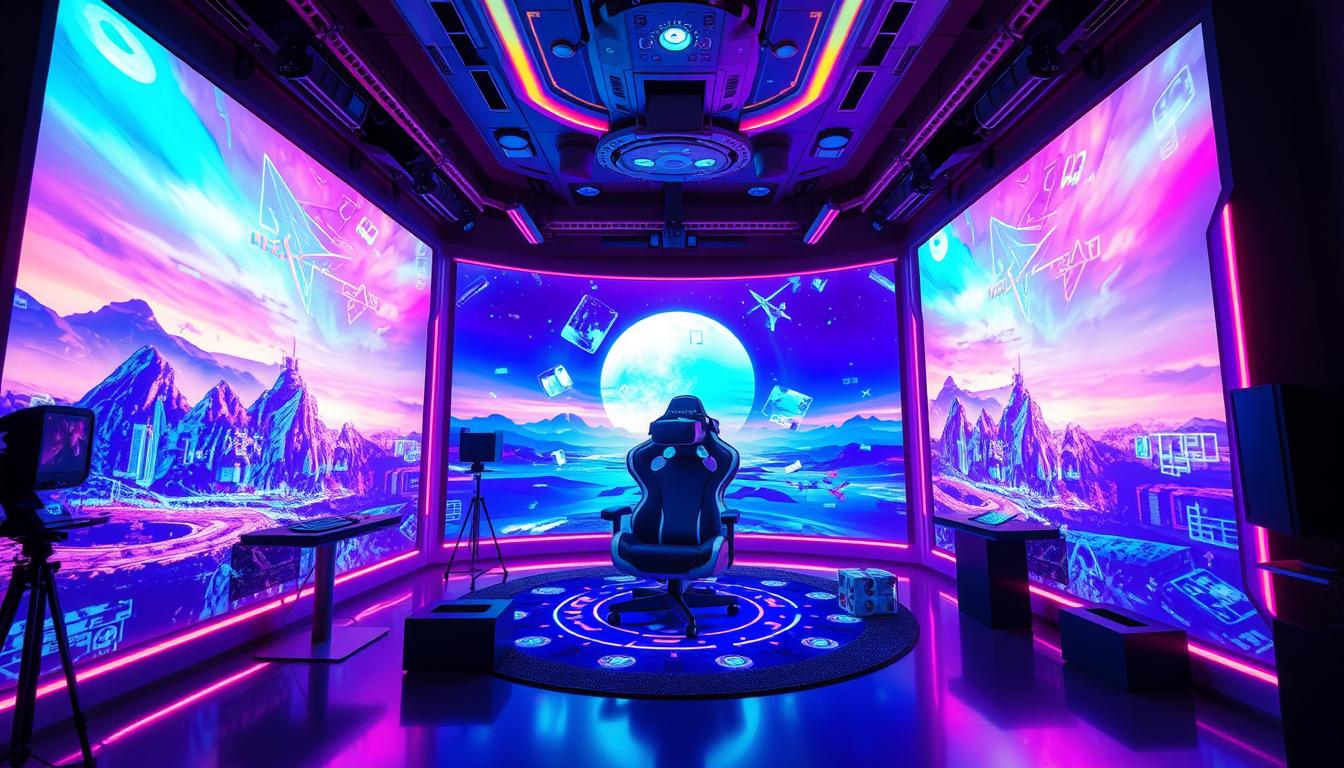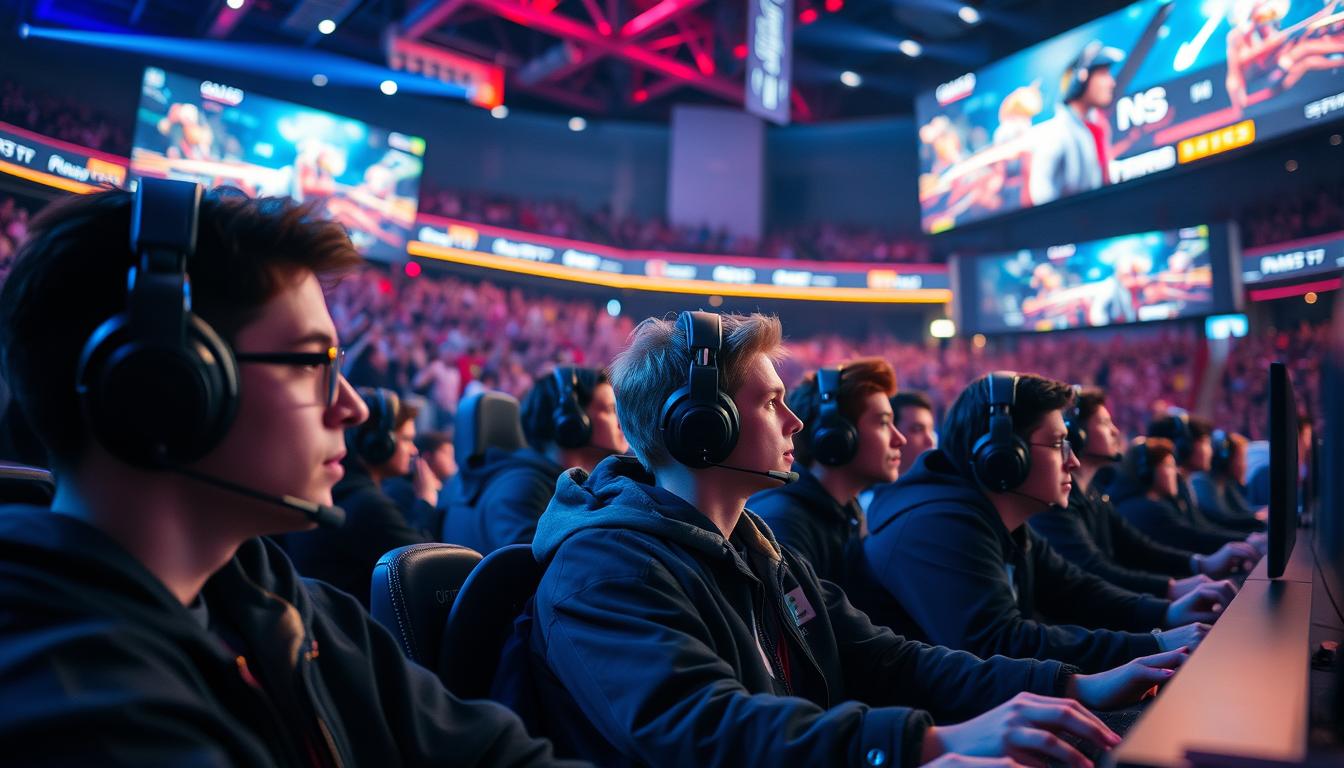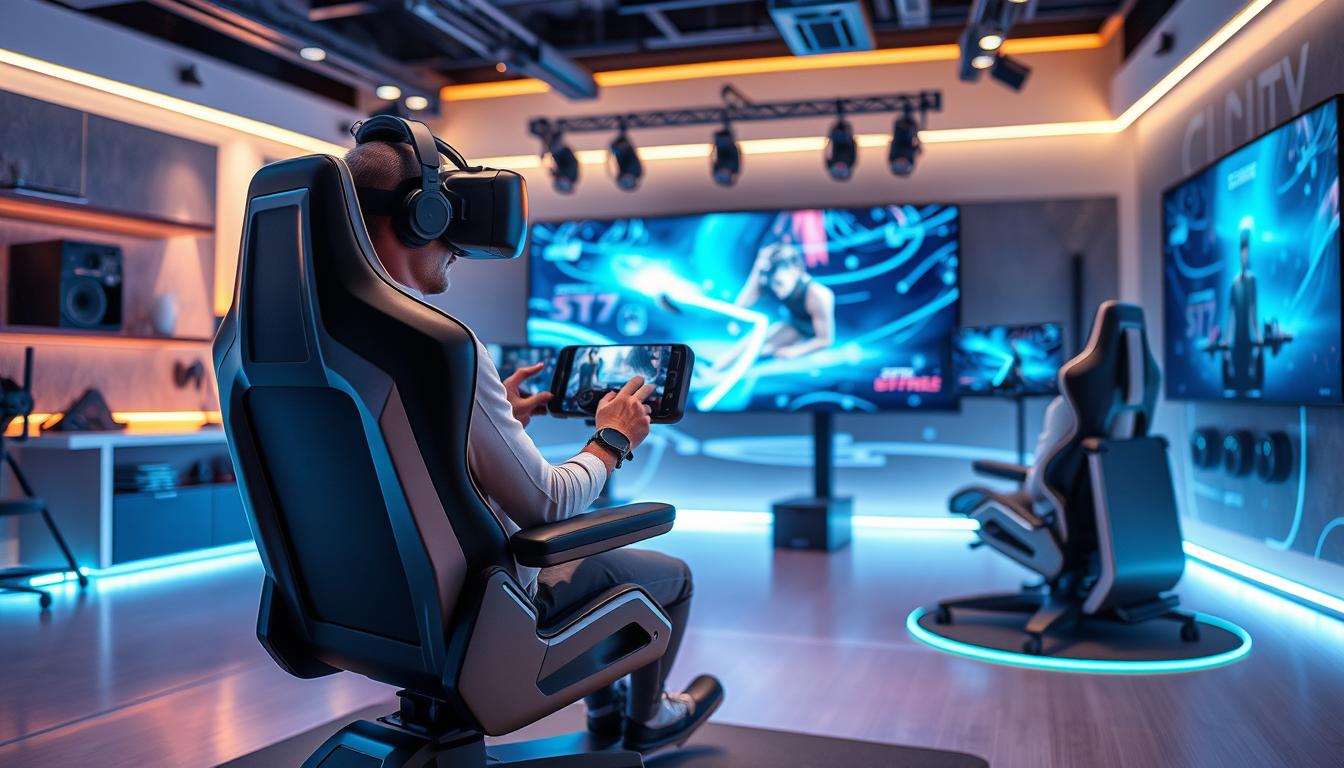We’re excited to explore the world of virtual reality gaming. This industry is expected to hit $45.09 billion by 2026, growing 30.5% each year. VR gaming is changing the gaming world with its immersive experiences. It’s also set to bring new levels of competition and fun to esports.
About 28% of gamers have tried VR gaming, showing it’s gaining popularity. In 2022, around 11.2 million VR headsets were sold worldwide. This shows people are really into VR and want more.
Market research shows 63% of gamers think VR makes games better. This proves that immersive tech is valued by many.
Key Takeaways
- The global Virtual Reality gaming market is projected to reach $45.09 billion by 2026.
- VR gaming has been shown to increase players’ engagement levels, with studies indicating a 20% improvement in retention rates.
- Approximately 63% of gamers believe that VR enhances their gaming experience.
- The average age of VR gamers is 35 years, with a balanced distribution between male and female players.
- Over 45% of gamers are interested in virtual reality experiences, highlighting a growing consumer base.
- VR gaming offers an immersive gaming experience that is changing the face of the gaming industry.
What is Virtual Reality Gaming?
Virtual reality gaming is an immersive experience that combines virtual reality technology with interactive games. This technology has been advancing quickly. The global virtual reality gaming market is expected to hit about $44.7 billion by 2024. It offers a unique and engaging experience, making it a major leap in gaming technology.
Some of the best virtual reality games show off what virtual reality technology can do. They provide an immersive experience that feels like real life. As technology advances, we’ll see even more advanced and engaging games.
Here are some key features of virtual reality gaming:
- Immersive experience with 3D graphics and spatial audio
- Interactive games that simulate real-world environments
- Advanced controllers that track movement and gestures
As virtual reality technology keeps evolving, we’ll see new and innovative games. With the market growing, we’ll see more best virtual reality games. These games will push the limits of what’s possible in virtual reality gaming.
The Rise of Virtual Reality in Gaming
Exploring virtual reality gaming, we see a journey of growth. The market has grown a lot, with a bright future ahead. Now, we have VR headsets like Oculus Rift, HTC Vive, and PlayStation VR. These have made gaming more real and fun.
The rise of VR gaming is due to more people using VR headsets and more games available. In 2022, the gaming industry made $184 billion, beating movies and sports. By 2025, VR gaming is expected to hit $45.09 billion, growing fast.
Historical Developments
The Oculus Rift’s Kickstarter in 2012 started a big push for VR in gaming. Now, we have standalone VR headsets like Oculus Quest. These make VR games easier to get into, thanks to cheaper hardware.
Major Innovations
Some big changes in VR gaming include:
- Social VR platforms like VRChat and Rec Room, which let VR and non-VR users play together
- More games available, covering different types and experiences
- VR headset prices have dropped from $600 in 2016 to about $400 in 2023
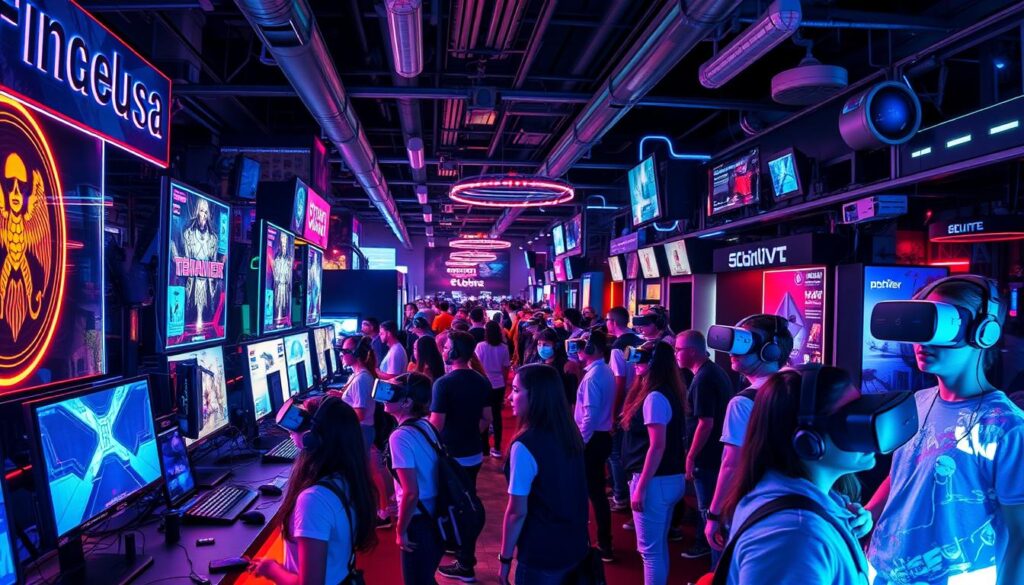
As VR gaming grows, we’ll see even more new things. With more VR headsets and games, the future of gaming looks amazing.
Popular Virtual Reality Platforms
We’re excited to dive into the top virtual reality platforms leading the VR gaming world. These platforms are key in shaping today’s virtual reality gaming trends. They’ve made big impacts on the industry. The Oculus Quest Series, PlayStation VR, and HTC Vive are among the leaders.
Choosing a virtual reality gaming headset can be tough. Here’s what each platform offers:
- Oculus Quest Series: Known for its standalone headsets, the Quest Series offers a wireless and immersive experience.
- PlayStation VR: Requires a PS5 to operate, this platform offers a more expensive but high-quality VR experience.
- HTC Vive: Offers advanced features like room-scale VR and motion controls, making it a popular choice among gamers.
The virtual reality gaming trends keep changing, with new tech and innovations every year. Looking ahead, it’s thrilling to see how these platforms will evolve. They’ll likely bring even more exciting experiences for gamers.
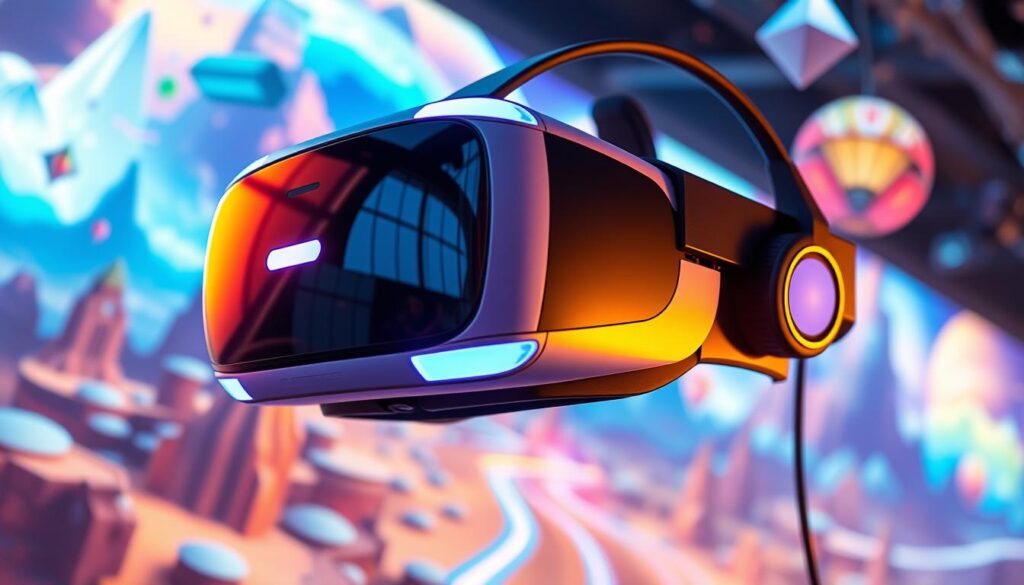
| Headset | Price | Resolution | Refresh Rate |
|---|---|---|---|
| Meta Quest 3 | $499.99 | 2,064 x 2,208 pixels | 120 Hz |
| Sony PlayStation VR2 | $439.99 | 2,000 x 2,040 pixels | 120 Hz |
| HTC Vive Pro 2 | $1,111.99 | 1,832 x 1,920 pixels | 120 Hz |
Each platform has its own special features and specs, meeting different needs and tastes. Whether you want a top-notch virtual reality gaming headset or something more budget-friendly, there’s a VR gaming option for you.
Immersive Experiences: How VR Games Engage Players
Virtual reality technology has changed the gaming world. It offers an immersive experience unlike anything else. Players can look around, touch objects, and move freely in the virtual world. This makes VR gaming stand out from traditional games, letting players feel like they’re part of the action.
To create an immersive experience, games must engage players’ senses. This is done through sensory details like realistic graphics, sound, and touch feedback. For instance, games like Half-Life: Alyx and Beat Saber use advanced graphics and physics for a deep experience. Haptic devices also add to the feeling of presence, making interactions feel more real.
Sensory Engagement
VR games engage players in many ways:
- Realistic graphics and environments
- Spatial audio and 3D sound
- Haptic feedback and motion tracking
These elements combine to create an experience that pulls players in and keeps them hooked. As the VR market grows, with a 42.05% CAGR from 2024 to 2029, we’ll see more exciting VR games.
Storytelling in VR
Storytelling is key in immersive gaming. VR games like Astro Bot Rescue Mission and The Climb take players to new worlds. They use VR’s power to craft engaging and unforgettable experiences.
Essential Gear for VR Gaming
For a great virtual reality gaming experience, the right gear is key. A top-notch virtual reality gaming headset is a must. It gives you a stereoscopic effect that makes VR games look amazing. Also, advanced VR gear lets you see incredible details and high-resolution graphics.
Don’t forget about controllers and accessories. Custom-made controllers, like guns, let you play games in a new way. High-quality headphones with surround sound make you feel like you’re right in the game. Some VR games need special gear, so getting the right stuff is important.
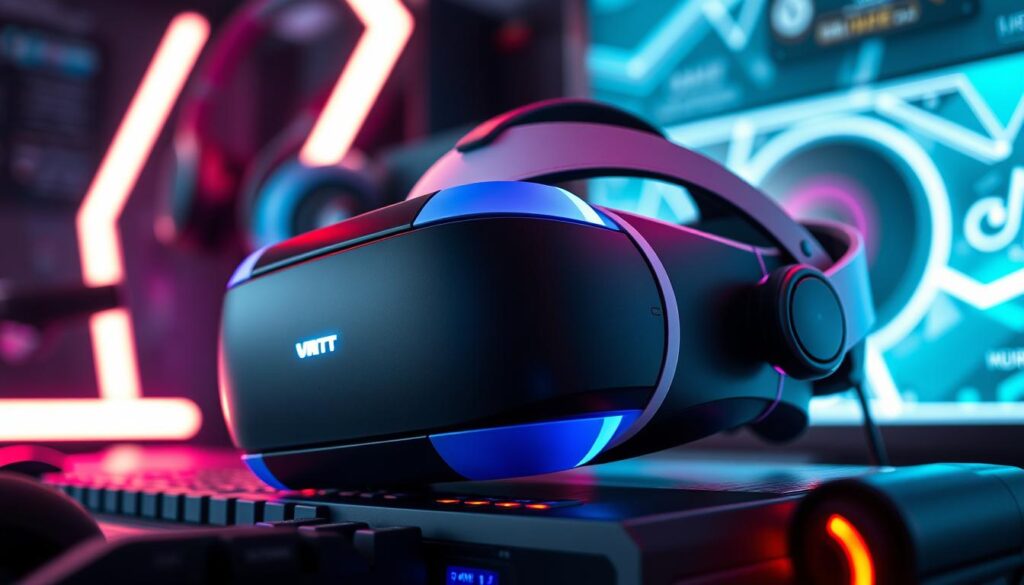
- VR motion controllers
- Haptic feedback devices
- VR gloves
- Tracking systems
These accessories make your gaming better, making it more fun and real. As VR gaming gets more popular, so does the need for good gear. Getting the right equipment is key to enjoying the best VR games.
| Accessory | Description |
|---|---|
| VR Headset | Provides a stereoscopic effect for an immersive experience |
| Controllers | Allow users to interact dynamically with the game |
| High-quality Headphones | Improve player interaction and immersion with surround sound |
The Impact of Virtual Reality on Game Design
Virtual reality is changing the game design world. It lets designers create immersive and interactive games. This opens up new ways for creativity, making games more engaging than ever.
Developers face a big challenge: making games simple yet complex. Simpler mechanics and exploration-centric gameplay are key. Games like Edge of Nowhere and Windlands show this, giving players a sense of freedom.
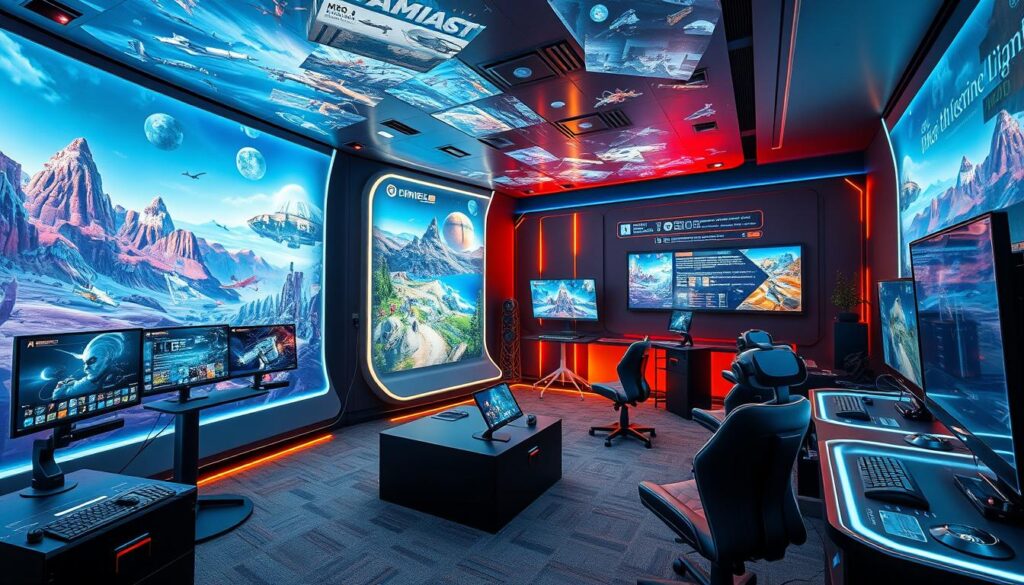
The future of gaming looks bright with virtual reality. Developers can now make games that look amazing and touch our hearts. Virtual reality lets designers tell stories in new ways, leaving a lasting impact on players.
Some benefits of virtual reality in game design include:
- Increased immersion and engagement
- Enhanced emotional impact and storytelling
- New avenues for creativity and innovation
Virtual reality is set to change the gaming world. It offers immersive and interactive experiences. By using virtual reality, developers can make games that are not just fun but also memorable and emotionally deep.
Multiplayer Experiences in Virtual Reality
We’re excited to dive into the social side of VR gaming. It lets players connect and play together in virtual worlds. This world of multiplayer VR is full of fun activities, like playing games and going to virtual events.
Games like Gorilla Tag, STRIDE Multiplayer, and POPULATION: ONE are popular in VR. They offer different play styles, from competing to working together. For example, POPULATION: ONE is like Grand Theft Auto in its immersive gameplay. STRIDE Multiplayer focuses on a unique way of playing that makes freerunning more exciting.
If you want to learn more about VR gaming, check out this article on virtual realities. It gives a good overview of VR and its uses. As VR gaming grows, we’ll see even more cool multiplayer games.
Social Interaction in VR
Social interaction is key in VR gaming, and multiplayer is no different. Players can talk, gesture, and even use body language. This makes the game more fun and engaging.
Popular Multiplayer Games
Here are some other top multiplayer VR games:
- Pavlov VR, a pioneering multiplayer first-person shooter
- Arizona Sunshine, a game with stunning graphics and a fun open-world zombie shooter experience
- Star Wars: Squadrons, where players can fight in dogfights as X-wing or TIE-fighter pilots in multiplayer
These games offer a variety of experiences. They’re all designed to make the most of VR’s immersive qualities.
The Future of Virtual Reality Gaming
Looking ahead, virtual reality gaming trends will shape the gaming world. New tech will bring us more immersive and interactive games. AI in VR will make games feel more personal, adapting to how we play.
VR, AR, and MR will blend together, changing gaming forever. This mix could make VR as common as phones. Expect better headsets, like the Meta Quest 3 and Apple Vision Pro, to hit the market soon.
Trends to Watch
Here are some trends to keep an eye on:
- AI will make games more personal
- Headsets will get better, with clearer views
- Games will be more interactive and fun
- The VR market will grow fast, with millions of users by 2024
Emerging Technologies
New tech like eye-tracking and haptic feedback will change VR gaming. They’ll help make games feel even more real and fun.
| Year | Number of Headset VR Users |
|---|---|
| 2017 | 11 million |
| 2023 | 32.7 million |
The VR gaming world is set to get even more exciting. With new tech and a growing market, the future looks bright.
Health and Safety in VR Gaming
Virtual reality gaming is exciting, but we must think about its effects on our bodies. We aim for fun and safety in gaming. VR makes games more fun and open to everyone, but we must use it wisely.
VR can change how we think and act, like real life. But too much VR can hurt our skills, like balance and multitasking. It’s smart to take breaks of 10 to 15 minutes after 30 minutes of VR.
Physical Implications
VR can make our heart rate and blood pressure go up, if it’s scary or violent. It can cause eye strain, dizziness, and nausea. These effects might last for hours after we stop using VR.
Children might not tell us if VR is making them uncomfortable. So, we should watch how long they use it.
Tips for Safe Play
To have a good time without harm, follow these tips:
- Take regular breaks every 30 minutes to prevent discomfort or adverse symptoms.
- Monitor children for symptoms of discomfort, including excessive drowsiness and decreased ability to multi-task, after using the headset.
- Avoid operating machinery or engaging in activities requiring unimpaired balance and coordination until all symptoms from VR use have completely subsided for several hours.
Knowing VR’s effects and taking steps to avoid them helps us enjoy gaming safely. As we dive deeper into VR, let’s keep our health and safety in mind for the best gaming experience.
Educational Uses of Virtual Reality Gaming
Virtual reality gaming is more than just fun; it’s also a powerful tool for learning. It makes education exciting and interactive. Students get to enjoy an immersive experience that makes learning a blast.
Studies show that virtual reality boosts learning. Students remember almost 9% more when they use it. It also helps them understand different cultures and feelings by letting them see the world in new ways.
Here are some ways virtual reality gaming is being used in education:
- Virtual field trips to places like Peru or China, letting students explore different cultures and environments.
- Interactive simulations that help students grasp complex ideas in a hands-on way.
- Personalized learning environments that meet each student’s needs and make learning more accessible.
As we keep improving virtual reality, we’ll see even more cool uses in schools. It has the power to change how we learn and teach.
Adding virtual reality gaming to classrooms makes learning more fun and effective. We’re all excited to see how it can improve education.
| Benefit | Description |
|---|---|
| Increased retention rates | Students who use virtual reality in their learning experience show an increase in retention of almost 9%. |
| Improved test scores | Virtual reality can help students develop emotional awareness and empathy, leading to improved test scores. |
| Personalized learning environments | Virtual reality can cater to individual needs and improve accessibility, creating a more effective learning experience. |
The Community and Culture of VR Gaming
The virtual reality gaming market is growing fast. This growth has created a lively community of VR fans. Players are connecting, sharing, and working together on virtual quests.
Online forums and VR platforms are hubs for gamers. They’re building strong bonds and a special culture around VR.
But it’s not just online. The VR community also meets up for exciting events. Esports tournaments, VR game showcases, and conferences are where players gather. They meet, try new tech, and celebrate their love for VR.
These events are more than just fun. They show off the latest in VR and bring gamers together. This camaraderie is key to VR’s future.
As the virtual reality gaming market grows, so will the community. Social connections, shared adventures, and events will help VR become more popular. They’ll also make VR gaming more important in our culture.
